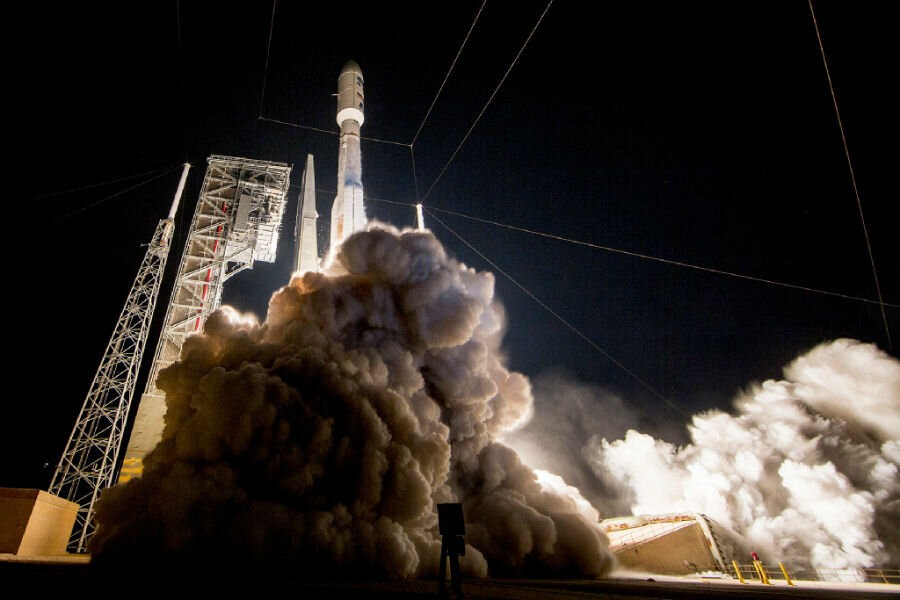Game-changing weather satellite launched into orbit
GOES-R, the most powerful weather satellite ever built, launched into orbit atop an Atlas V rocket Saturday evening from Cape Canaveral, Fla. The weather satellite is the first of a new generation of satellites operated by the National Oceanic and Atmospheric Administration (NOAA) that is expected to improve weather forecasting across the entire Western hemisphere.
The satellite launched at 6:42 PM EST from Cape Canaveral Air Force station. It took about 12 minutes for the rocket to boost the high-tech piece of equipment into orbit.
GOES-R, which stands for Geostationary Operational Environmental Satellite, is the 16th in the GOES series. Once it reaches its final orbit in two weeks, its name will be changed to GOES-16 to reflect its technological heritage. But the super-advanced GOES-R is a far cry from its ancestors, the first of which was launched in 1975.
"For weather forecasters, GOES-R will be similar to going from a black-and-white TV to super-high-definition TV," Stephen Volz, assistant administrator for NOAA's Satellite and Information Services division, said during a pre-launch news conference on Thursday. "For the American public, that will mean faster, more accurate weather forecasts and warnings. That also will mean more lives saved and better environmental intelligence for state and local officials and all decision makers."
As the Monitor previously reported, GOES-R's final orbit will be geosynchronous, meaning that it will remain in the same relative point in space above the Earth, matching our planet's daily rotation, at a height of about 22,000 miles. It has enough fuel to remain there for up to 18 years, though currently it is expected to operate only for a decade.
"We’ll be able to [image] the whole hemisphere every five minutes or better yet, for a hurricane or a big thunderstorm, we'll be able to actually focus in and do updates every 30 seconds," Greg Mandt, NOAA’s GOES-R program director, told CBS. "And we get the data to the forecasters within seconds or minutes. So in a sense, it's like watching it with a camera in real time so they can really watch what's going on, how it's unfolding and therefore make much more precise warnings of the significant weather events that are coming on."
Because of the high precision and fast imaging rate, GOES-R is expected to save lives in the event of destructive weather events by using the Advanced Baseline Imager (ABI) camera. The ABI is capable of taking pictures five times faster than, and with four times the resolution of, current GOES cameras. GOES-R is also equipped with a magnetometer to measure solar radiation in the upper atmosphere, a UV imager to monitor the sun, sensors to measure charged solar particles, and a lightning mapper that will take infrared photos 200 times a second of areas with active electrical disturbances.
"The launch of GOES-R represents a major step forward in terms of our ability to provide more timely and accurate information that is critical for life-saving weather forecasts and warnings," said Thomas Zurbuchen, associate administrator for NASA’s Science Mission Directorate in Washington, in a statement from NASA. "It also continues a decades-long partnership between NASA and NOAA to successfully build and launch geostationary environmental satellites."
The launch of GOES-R had been rescheduled due to damage from Hurricane Matthew, and was delayed by another hour on the day of the launch because of technical glitches. But the flight itself seemed to go off without a hitch, marking the 100th launch for the US Air Force's Evolved Expendable Launch Vehicle program, which was created in the 1990s to create a more reliable and affordable means of launching cargo into orbit. This milestone is matched only by the technological significance of GOES-R, which is the first of four next-generation satellites that will monitor weather patterns through 2036.
"For 40 years, we've sort of had the same simple pictures," Mr. Mandt told Spaceflight Now. "Meteorologists are calling this a game-changer from their ability to watch what's going on and warn the nation."






